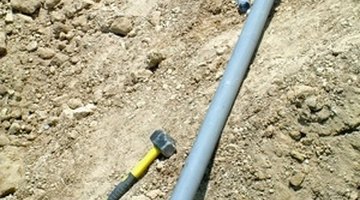How to Repair a Broken Flexible PVC Pipe
Polyvinyl chloride---or PVC---pipe, which is widely used in plumbing, is a plastic pipe that is flexible, easy to cut and durable. Although it typically lasts for years, PVC pipe may require repairs from time to time. To repair PVC pipe, locate and cut out the faulty section and replace it with a new piece, adding fittings to hold it in place.

-
Locate the valve controlling the flow of water to the damaged pipe. Turn the valve to the off position. Most valves are labeled, however if it is not, then turn the handle of the valve so that it is perpendicular to the direction the pipe is running. If the valve handle is circular, turn it clockwise to close it.
-
Locate the damaged section of pipe, which will be evident by the leaking water and possibly a visible crack or hole in the pipe. Gently shift the pipe an inch or two in either direction to exposed the flaw so you may determine how much of the pipe must be cut away.
-
Place the bucket under the damaged area to catch additional water in the pipe that might drain out as the pipe is cut and the section removed.
-
Cut the pipe, using the hack saw, two inches to each side of the flaw. Allow any standing water in the pipe to drain into the bucket. Discard the bad section of PVC pipe.
-
Use the utility knife to scrape away burrs and debris from each end of the pipe.
-
Dry both ends of the pipe inside and out with a cloth rag. Ensure the pipe is free of debris and moisture so the cement will adhere to the pipe and form a good seal.
-
Dry-fit the PVC couplers by sliding one on each end of the existing pipe without applying cement. With a fitting on each end of the pipe, measure from the middle of one fitting to the middle of the other fitting. This will provide the length of the pipe needed to fill in the gap.
-
Cut a piece of PVC pipe to the exact measurement taken from Step 7. Scrape the edges with a knife to remove the burrs.
-
Remove the fittings from each end of the existing PVC pipe. Apply cement on each end of the existing PVC pipe and on the inside of one end of each fitting. Slide the cemented end of each fitting onto the cemented ends of the pipe, twisting each fitting back and forth to ensure it attached securely.
-
Apply cement to outside of one end of the new piece of PVC pipe, and to the inside of one of the fittings. Insert the cemented end of the pipe into this fitting and twist it to fully seat the pipe in the fitting.
-
Apply cement to the outside of the other end of the new pipe and to the inside of the remaining fitting. Insert the pipe into the fitting. Gently bend the PVC pipe to create slack required to insert the end of the pipe into the fitting. Avoid bending the pipe so far as to cause a kink or fold in the pipe.
-
Allow the cement to set for two minutes.
-
Open the valve and check for leaks.
Resources
Tips
- Work quickly after applying cement to the PVC pipes as it initially sets in just a minute or two.
Warnings
- Be sure to have proper ventilation when working with the cement to avoid direct inhalation of the fumes.
Writer Bio
Laurie Brown has worked as a high school English teacher for the last several years and loves writing. She enjoys helping her students develop a love and appreciation for writing, reading, and literature. Laurie has a degree in education with a major in English. Currently she is a writer for eHow.
Photo Credits
- pvc image by Greg Pickens from Fotolia.com
More Articles



